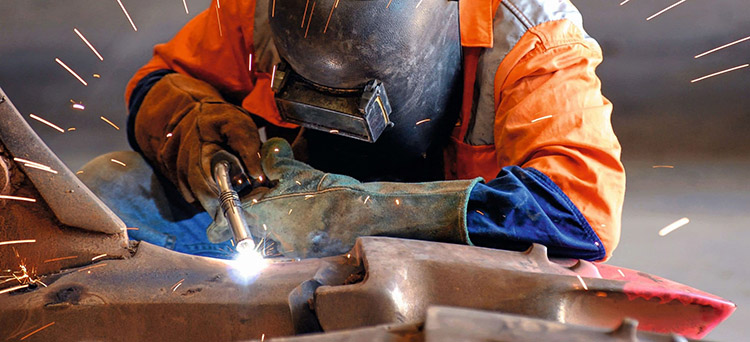High-carbon steel refers to carbon steel with w(C) higher than 0.6%, which has a greater tendency to harden than medium-carbon steel, and forms high-carbon martensite, which is more sensitive to the formation of cold cracks. At the same time, the martensite structure formed in the heat-affected zone of welding is hard and brittle, which leads to a great decrease in the plasticity and toughness of the joint. Therefore, the weldability of high-carbon steel is quite poor, and a special welding process must be adopted to ensure the performance of the joint. . Therefore, it is generally rarely used in welded structures. High carbon steel is mainly used for machine parts that require high hardness and wear resistance, such as shafts, large gears and couplings. In order to save steel and simplify the processing technology, these machine parts are often combined with welded structures. Welding of high carbon steel components is also encountered in heavy machine building. When formulating the welding process of high carbon steel weldment, all kinds of welding defects that may occur should be comprehensively analyzed, and corresponding welding process measures should be taken.
1. Weldability of high carbon steel
1.1 Welding method
High carbon steel is mainly used in structures with high hardness and high wear resistance, so the main welding methods are electrode arc welding, brazing and submerged arc welding.
1.2 Welding materials
Welding of high carbon steel generally does not require the same strength between the joint and the base metal. Low-hydrogen electrodes with strong desulfurization ability, low diffusible hydrogen content of deposited metal, and good toughness are generally selected for electrode arc welding. When the strength of the weld metal and the base metal is required, a low-hydrogen electrode of the corresponding level should be selected; when the strength of the weld metal and the base metal is not required, a low-hydrogen electrode with a strength level lower than that of the base metal should be selected. An electrode with a higher strength level than the base metal cannot be selected. If the base metal is not allowed to be preheated during welding, in order to prevent cold cracks in the heat-affected zone, austenitic stainless steel electrodes can be used to obtain an austenite structure with good plasticity and strong crack resistance.
1.3 Groove preparation
In order to limit the mass fraction of carbon in the weld metal, the fusion ratio should be reduced, so U-shaped or V-shaped grooves are generally used during welding, and care should be taken to clean the groove and the oil stains and rust within 20mm on both sides of the groove.
1.4 Preheating
When welding with structural steel electrodes, it must be preheated before welding, and the preheating temperature should be controlled at 250°C to 350°C.
1.5 Interlayer processing
For multi-layer multi-pass welding, the first pass uses small-diameter electrodes and low-current welding. Generally, the workpiece is placed in semi-vertical welding or the welding rod is used to swing laterally, so that the entire heat-affected zone of the base metal is heated in a short time to obtain preheating and heat preservation effects.
1.6 Post-weld heat treatment
Immediately after welding, the workpiece is put into the heating furnace, and the heat preservation is carried out at 650°C for stress relief annealing.
2. Welding defects of high carbon steel and preventive measures
Due to the high hardening tendency of high carbon steel, hot cracks and cold cracks are prone to occur during welding.
2.1 Preventive measures for thermal cracks
1) Control the chemical composition of the weld, strictly control the content of sulfur and phosphorus, and appropriately increase the manganese content to improve the weld structure and reduce segregation.
2) Control the cross-sectional shape of the weld, and the width-to-depth ratio should be slightly larger to avoid segregation in the center of the weld.
3) For weldments with high rigidity, appropriate welding parameters, appropriate welding sequence and direction should be selected.
4) If necessary, take preheating and slow cooling measures to prevent the occurrence of thermal cracks.
5) Increase the alkalinity of the electrode or flux to reduce the impurity content in the weld and improve the degree of segregation.
2.2 Preventive measures for cold cracks.
1) Preheating before welding and slow cooling after welding can not only reduce the hardness and brittleness of the heat-affected zone, but also accelerate the outward diffusion of hydrogen in the weld.
2) Select the appropriate welding measures.
3) Adopt appropriate assembly and welding sequences to reduce the restraint stress of welded joints and improve the stress state of weldments.
3 .Conclusion
Due to the high carbon content, high hardenability and poor weldability of high carbon steel, it is easy to produce high carbon martensitic structure during welding, and it is easy to produce welding cracks. Therefore, when welding high carbon steel, the welding process should be reasonably selected. And take corresponding measures in time to reduce the occurrence of welding cracks and improve the performance of welded joints.
Post time: Jul-18-2023

